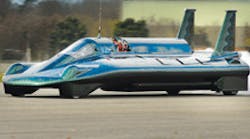Authored by: Resources: |
The official, FIA-recognized world speed record for steam-powered cars, 127.659 mph, was set by Fred Marriott driving a Stanley Steamer in 1906 and remains the longest standing land speed record. But that could change this September when the British Steam Team takes its car, Inspiration, out for a record run during Speed Week at the Bonneville Salt Flats. Though technically they just have to beat the 1906 record, the team believes it won’t be truly successful unless it sets a record of at least 200 mph.
The team has been building the car over the past six years and now has it almost ready for the Salt Flats. The 25-ft long, 3-ton car will burn liquid propane in 12 suitcase-sized boilers arranged in three rows of four. Exhaust from all the boilers is vented into a channel running down the center of the car. Intakes and other relatively cool boiler components will line the car’s sides. Each boiler must provide 3.3 lpm of steam. Tests on the first production boiler had it making 3.7 lpm, well within specs. All told, there will be 1.86 miles of boiler tubing in the car. The team will also carry two spare boilers.
Compressed air keeps the demineralized water pressurized to 40 bar before it enters the boilers’ preheaters. From there, it flows into the 3-MW heater matrix where it is transformed into steam. (Because the water is at 40 bar, it boils at 250°C.) Just before leaving the boilers, a superheater conditions this wet steam into good quality, 400°C dry steam. All of the steam, about 40 kg/ min, feeds into a two-stage turbine at twice the speed of sound, letting it go through a ton of water every 25 min and spin at 13,000 rpm. This generates about 300 bhp, enough to take the car to 200 mph, according to calculations. The turbine drives the rear wheels through a crown wheel-and-pinion reduction gear.
Steam pipes running through the 12 boilers are stainless steel and up to 11- mm thick in places to cope with the 400°C steam and 40 bar pressures inside of them.
At first, insulation around the boilers let the burner sit at 1,035°C while exhaust was at 160°C and the casing remained relatively cool. But after tests, the insulation was brittle and had shrunk, showing it has been at least 1,200°C. So the team added high-temperature silica-and- ceramic cloth insulation around the boilers and covered that with thin sheets of titanium.
The car’s backbone is a steel space-frame chassis which is beefed up with carbon-fiber composites and covered in an aluminum skin.
It takes three pieces of ancillary equipment just to start the car: One to provide water, a second providing LPG and compressed air, and the third electrical power. So for the record run, the team will need to position a total of six rigs, three at the starting point and three at the turnaround point 6 miles away.
The car takes 8 min to start, then has enough fuel, compressed air, and water to run for 3 min. The team is confident they can set the record in less than 2 min and turn the car around quickly for the second run. (The FIA demands two runs in opposite directions down a measured mile, with only an hour allotted for refueling and servicing the vehicle between runs.
